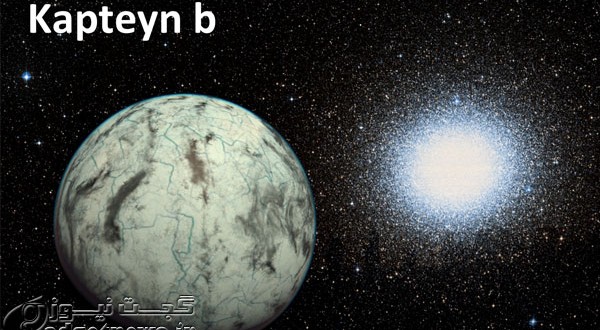
سیاره Kapteyn b که فقط 13 سال نوری از زمین فاصله دارد، هماکنون قدیمیترین سیاره صخرهای شناختهشده در یک منطقه زیستپذیر به شمار میآید.این سیاره پنج برابر زمین جرم دارد و هر 48 روز یک بار حول ستاره والدش میچرخد. خود ستاره والد که Kapteyn نام دارد، سریعتر از هر ستاره مجاور زمین، عرض آسمان را طی میکند.
ستاره مزبور به همراه دو سیارهاش که اخیرا کشف شدهاند، هماکنون بسیار دورتر از محل آغازین شکلگیریشان در خارج از کهکشان راه شیری قرار دارند. ستاره «کپتین» در اواخر سال 1890 توسط «جیکاب کورنلیوس کپتین» هلندی کشف شد و یک کوتوله قرمزرنگ M1 است. این جرم کیهانی ستارهای خنک و کوچک بوده و عامترین نوع ستاره در کهکشان راه شیری به شمار میآید.
در حالی که دمای سطح خورشید بین پنج تا شش هزار درجه کلوین گزارش شده، دمای سطح کپتین بیش از 3500 درجه کلوین گزارش شده است. علاوه برخنکتر بودن، این ستاره یک سوم خورشید جرم دارد و در مقایسه با خورشید جوان 4.6 میلیارد ساله، کمی مسنتر است.
تصور میشود کپتین یکی از اعضای گروهی باستانی باشد که در روزهای آغازین زمین شکل گرفته است. ستارههای کوتوله گروه M اهداف مطلوبی برای شکار سیارات فراخورشیدی هستند. زیرا میتوان این سیارات را که اندکی بزرگتر از زمین هستند، در مجاور این ستارگان کشف کرد.
تیمی بینالمللی متشکل از 20 منجم، دادههای حاصل از سه تلسکوپ بزرگ را برای مطالعه سیارههای این ستاره به نامهای «کپتین b» و «کپتین c» تحلیل کردند. این سیارات به ترتیب طی بازههای زمانی 48 و 120 روز حول ستاره والدشان مدارگردی میکنند.
در این میان، «کپتین b» تنها سیارهای است که در منطقه زیستپذیر قرار دارد، اما «کپتین c» که دست کم هفت برابر زمین جرم دارد، جسمی صخرهای و بسیار دورتر از ستاره میزبانش است، بنابراین نمیتواند میزبان آب مایع باشد.
دکتر آنگلادا اسکوده از دانشگاه کوئین مری لندن رهبر ارشد این مطالعه گزارش شد.در پایان اشکال و نمودارهایی برای روشن تر شدن مطلب آورده میشود.
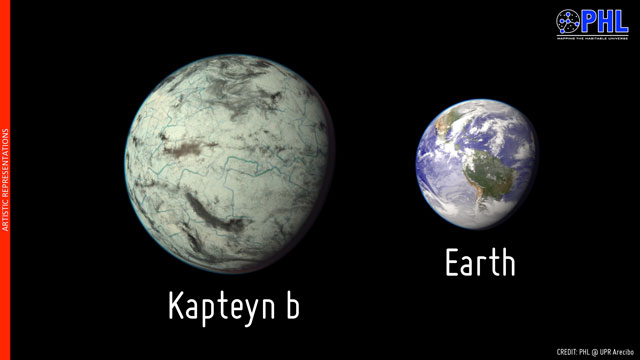
در این شکل، کپتین-بی و زمین در کنار یکدیگر تصویر شدهاند تا اندازه حدودی کپتین-بی مشخص شود. کپتین-بی را لایهای از ابر پوشانده است. شبکههای اتصال آب در کپتین-بی را نیز مشاهده میکنید.
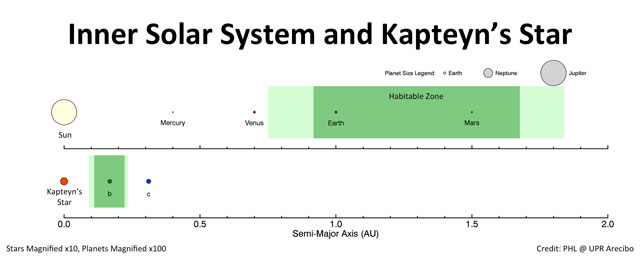
در این شکل، منطقه قرارگیری زمین در برابر خورشید و همچنین محدودهای که در آن با توجه به درجه حرارت امکان زندگی وجود دارد مشاهده میشود. همین شکل برای کپتین-بی و ستاره آن یعنی کپتین هم دیده میشود. محدوده سبز رنگ، محدودهایست که امکان زندگی در آن وجود دارد.
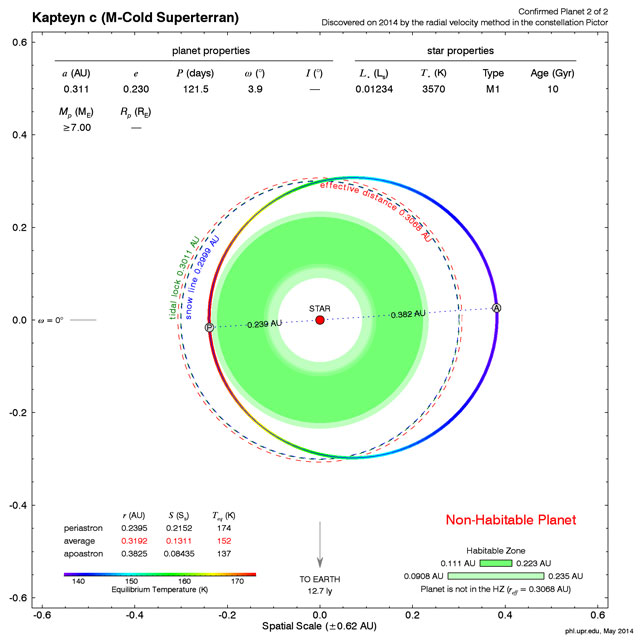
در این شکل، مشخصات و جزئیات مدار گردش کپتین-بی را مشاهده می کنید.
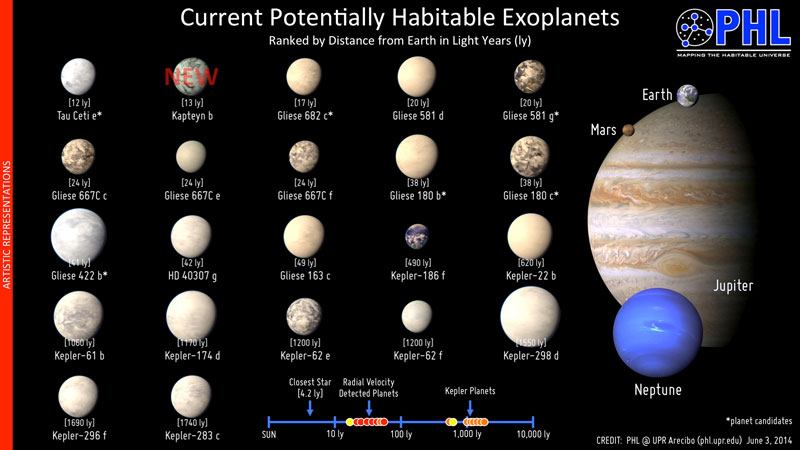
در این شکل تمام سیاراتی که امکان بالقوه سکونت در آنها وجود دارد بر اساس فاصله تا زمین دیده میشوند. کپتین-بی عضو جدید این فهرست است.
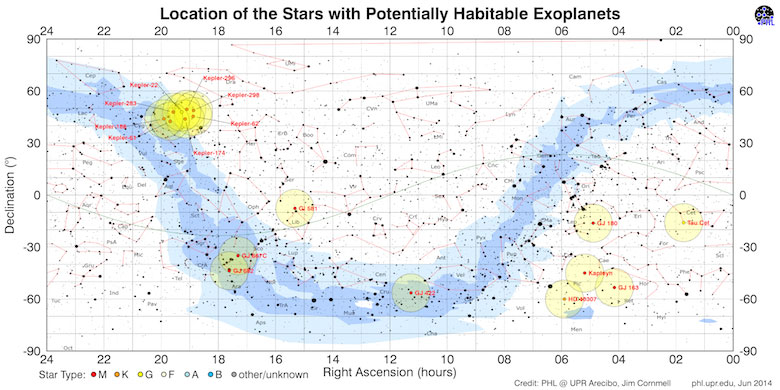
نقشه ستارهای، با مشخص شدن جایگاه سیاراتی که امکان بالقوه سکونت انسان را دارند.
منبع : phl.upr.edu
Oldest Known Potentially Habitable Exoplanet Found
The planets around the nearby red-dwarf Kapteyn's star are over twice as old as Earth
An international team of astronomers, led by Guillem Anglada-Escude from Queen Mary University, reports two new planets orbiting a very old and nearby star to the Sun named Kapteyn's star. One of the newly-discovered planets, Kapteyn b, is potentially habitable as it has the right-size and orbit to support liquid water on its surface. What makes this discovery highly interesting is the peculiar story and age of the star. Kapteyn b is likely over twice the age of Earth and the oldest known potentially habitable planet listed in the Habitable Exoplanets Catalog.
The Super-Earth Kapteyn b orbits the star every 48 days and has a mass at least five times that of Earth's. The second planet, Kapteyn c, is a more massive Super-Earth with an orbit of 121 days and too cold to support liquid water. At the moment, only a few properties of the planets are known: minimum masses, orbital periods, and distances to the star. By measuring their atmospheres with future instruments, scientists will try to find out whether some of these planets are truly habitable worlds.
Kapteyn b is probably colder than Earth given a similar atmosphere. However a denser atmosphere could easily provide for equal or even higher temperatures. Based on its stellar flux (45% that of Earth's) and mass (≥ 4.8 Earth masses) the Earth Similarity Index (ESI) of Kapteyn b is comparable to Kepler-62f and Kepler-186f. Given its old age (~11.5 billion years), Kapteyn b has had plenty of time to develop life, as we know it.
The astronomers used new data from HARPS spectrometer at the ESO's La Silla observatory in Chile to measure tiny periodic changes in the motion of the star. Using the Doppler Effect, which shifts the star’s light spectrum depending on its velocity, the scientists worked out some properties of these planets, such as their masses and orbital periods.The study also combined data from two more high-precision spectrometers to secure the detection: HIRES at Keck Observatory and PFS at Magellan/Las Campanas Observatory.
About Kapteyn's Star
Discovered at the end of the 19th century and named after the Dutch astronomer who found it (Jacobus Kapteyn), Kapteyn's is the second fastest moving star in the sky and belongs to the galactic halo, an extended cloud of stars orbiting our Galaxy in very elliptic orbits. With a third of the mass of the Sun, this red-dwarf can be seen in the southern constellation of Pictor with an amateur telescope.
Typical planetary systems detected by NASA's Kepler mission are hundreds of light-years away. In contrast, Kapteyn's star is the 25th nearest star to the Sun and it is only 13 light years away from Earth. It was born in a dwarf Galaxy absorbed and disrupted by the Early Milky Way. Such a galactic disruption event put the star in its fast halo orbit. The likely remnant core of the original dwarf galaxy is Omega Centauri, an enigmatic globular cluster 16,000 light years from Earth which contains hundreds of thousands of similarly old suns. This sets the most likely age of its planets at 11.5 billion years; which is 2.5 times older than Earth and 'only' 2 billion years younger than the Universe itself (~13.7 billion years).
 گجت نیوز آخرین اخبار تکنولوژی، علم و خودرو
گجت نیوز آخرین اخبار تکنولوژی، علم و خودرو 






